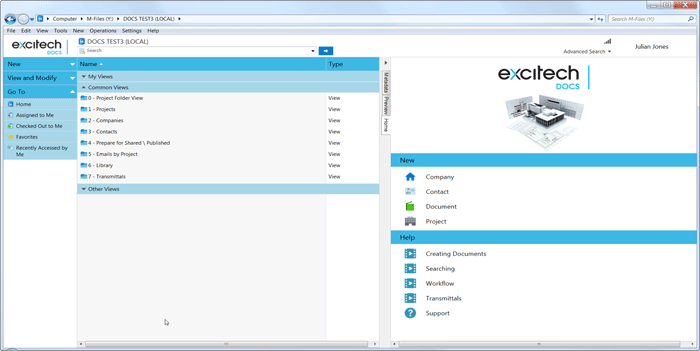While BIM adopters typically take a model-centric approach to design, collaboration is all about document flow. Document management may not be the most exciting topic in BIM, but operating without it and defaulting to managed folders on a Windows desktop could be a recipe for disaster, writes Martyn Day
While the sexy aspect of BIM lies in the modelling, the power of BIM is still in the ‘I’, the information collated in models and shared among project teams. While sharing models is a topic that has solutions all of its own, the industry is still built on producing 2D documents, sections, elevations in PDF, as well as email and Office documents – all of which need to be shared, too.
The UK is striving to codify BIM naming conventions and processes, in an attempt to produce a nationwide standard that all project disciplines can adopt to ease collaboration and get everyone talking the same language.
The reality of this is that object definitions and processes are quite complex and require a lot of internal effort to understand and implement. Even when that has been done, getting project teams to follow these quality standards is yet another challenge.
UK reseller Excitech has developed a document management system specifically designed to assist with the adoption of key elements of PAS 1192 and to automate criteria essential to attaining BIM level 2 accreditation. The kicker is it aims to deliver this without involving an onerous undertaking or costing the earth.
Behind the development is Alec Milton, who AEC Magazine has known for many years. Formerly at Oasys (Arup’s software arm), Milton was responsible for creating its highly popular document management products Columbus and Mail Manager. Excitech DOCS seems like a continuation of this philosophy to provide simple document management, but with a more robust underlying platform provided by an M-Files engine. M-Files isn’t a typical folder repository. Instead, it uses metadata and context, making searching fast and intelligent.
DOCS in detail
The product’s purpose is neatly encapsulated in its name. Excitech DOCS is all about the documents that are generated in the design process. It’s not a replacement for Revit Server and it doesn’t offer model-sharing capabilities for programmes such as Navisworks. Its niche is very much in document management, preparation, naming, mail management, transmittals workflow and search.
The scope is limited compared to other document management systems such as ProjectWise, or services offered by online portals, but what it does, it does very well, for a very reasonable price, without requiring weeks of deployment and extensive training. Excitech claims that a 4-day implementation is typical, including training.
Excitech DOCS is targeted at Revit and AutoCAD workflows, although it is accessible via iOS, Android and even Windows Phone for viewing, mark-up and approval anywhere. The application resides on the client’s server and so does not transfer data to a third-party cloud.
On the desktop, there are in-ribbon access tools provided for both Autodesk Revit and AutoCAD products, enabling access from within the core documentation tools. As the system is based on ‘objects’ and associated metadata, search is very powerful and can find words in emails, projects, specified time periods and drawings. There’s also a powerful batch plot capability.
Workflow: Excitech DOCS supports the workflows of PAS1192-2:2013 and the document file naming of BS1192:2007+A2:2016. It will automatically name drawings and revisions in title blocks in both Revit and AutoCAD. As it is a UK product, DOCs comes with PAS1192-2:2013 workflow built in, supporting work in progress, review, approval, document locking and audit trails. It gives a clear visual representation of where DWG/DWF and PDF documents are within the process. In future, I suspect other workflows will be added and customers will be able to create their own.
Email: With an Outlook integration, it’s easy to drag and drop emails into the projects and have those associated with documents. This is similar to Mail Manager, but at the moment, not as advanced. Milton explained that this capability will be developed further and that Excitech also has an integration with Mail Manager for firms that use the Oasys application. Obviously, this isn’t foolproof; it relies on the user to drag and drop the relevant emails into the system.
Transmittals: This was a big request from the early beta tester of Excitech DOCS and was added prior to launch. The system enables the automatic packaging-up of project documents and automatically generates transmittal sheets, creating records of document packages sent to other firms.
Conclusion
As a Revit reseller with a long history in selling document management systems, it’s clear that Excitech realised that there was a gap in the market for something that helped customers better comply with PAS1192 and move beyond folders on desktops, without having to have to adopt and pay for a huge document management system with expensive accounting and system integration.
Excitech DOCS comes in three flavours, the most expensive being £575 for a power (AutoCAD/Revit) user licence, together with the first year’s maintenance at £690. However, in subsequent years, this drops to just over £115 per licence for maintenance (licenses are not subscription but perpetual). There are two lower-cost licenses: for Office users (Office Docs); and a Read-Only licence.
If you enjoyed this article, subscribe to AEC Magazine for FREE






